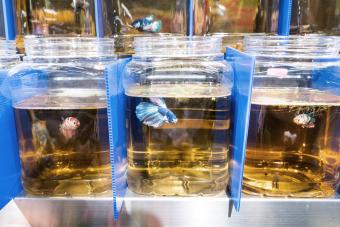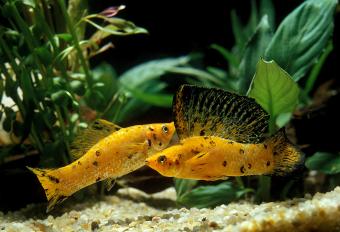
It's a fact of life that betta fish sometimes become sick. You can prevent most betta diseases from taking hold by keeping your betta's tank clean and feeding them an appropriate diet. However, the day may come when your fish just doesn't act like themselves and you suspect you might have a sick betta. Learn about some of the most common betta fish illnesses and how they are treated.
Common Betta Diseases
Although there are many betta fish illnesses, the following conditions are the ones a pet owner will most likely ever have to deal with.
Fin Rot

Fin rot is a betta bacterial infection of the fins that virtually eats away at them. At first glance, a fish's fins or mouth may look damaged. This could have been the first problem that led to infection. Fins, mouths, and tails, on the other hand, degrade and rot away with time. If a fungal infection isn't visible, the fish is most likely suffering from fin rot.
It's typically brought on by poor water conditions that stress the fish and lower their immune system's ability to fight disease. If left untreated, the infection will work its way into the betta's body and eventually kill them.
Treatment consists of a complete water change and medicating the fish with tetracycline for the initial bacterial infection and anti-fungal medication to stave off an opportunistic secondary infection.
Constipation
Constipation is the result of overfeeding your betta. Signs of constipation include a lack of appetite, swollen abdomen, and an absence of feces in the bottom of the tank.
Treatment often involves fasting the betta for a day or two. Another remedy is to feed the fish a single frozen pea with the skin removed. The fiber helps move the blockage. Remove any uneaten parts of the pea after 20 minutes.
Ich
Ich is a betta fish parasite infection, and these organisms are almost always present and waiting for an opportunity to latch onto a host. Ichthyophthirius multifiliis, an ecotparasite (a parasite that lives outside the body) that encysts itself inside the white patches on the fish's skin and scales, is the cause. If therapy is not given, it affects the body and, in virtually all cases, kills the host over time.
The first sign is a few white spots on a betta's scales that look like tiny cotton balls. These are actually cysts that harbor the immature stage of the parasites, known as tomites. The fish will also clamp their fins and rub up against any surface in the tank as they try to dislodge the parasites.
Ich can only be treated in the free swimming stage, so you need to remove your carbon filter, add an ich treatment, such as malachite green, to the water, and raise the tank temperature to 85 degrees Fahrenheit. This encourages the cysts to detach and burst. This, in turn, releases the tomites, and then the medication in the water can kill them.
Velvet
This is another parasitic infection. Velvet is one of the most frequent diseases in aquarium fish, and it can kill all of the inhabitants before the unsuspecting owner realizes what they are up against. It is caused by one of several species of a small parasite known as Oödinium, which is also known as Rust or Gold Dust illness.
Oödinium is a dinoflagellate, a creature that has chlorophyll and is classed as a protozoan by some and algae by others. This is a parasite that affects both freshwater and saltwater fish. An affected betta will have a gray to golden coating on their body. Sometimes this isn't easy to see, but velvet should show up under good lighting.
The treatment for velvet is basically the same as for ich.
Betta Fish Fungal Infections
Fungal spores can be found in almost every aquarium setting. Fungal infections are particularly common in aquariums due to these spores. They can take hold any time there is damage to a betta's slime coat. An affected fish looks as though they are wearing cotton.
Treatment involves adding a fungicide to the tank. You may also need to spot treat the fish with methylene blue or gentian violet.
Swim Bladder Disease
Swim bladder disease affects your betta's ability to swim normally. You may notice they have trouble maintaining their balance and swim on one side, upside down, or perhaps have difficulty swimming to the top or bottom of the tank. The problem is usually due to a bacterial infection often brought on by poor water quality, but injuries sustained during transportation, breeding, or fighting can also produce this condition.
Treatment involves moving the affected betta to a shallow tank where the water line will only be a few inches above their top fin. Treat the water with an antibiotic and make daily water changes until the fish recovers.
Tips for Treating Diseases in Sick Betta Fish
You can improve your pet's chance of recovery if you follow these tips.
Quaratine Sick Fish in a Hospital Tank

Quarantining diseased fish before re-introducing them into their aquarium should prevent further spread of the infection. A hospital tank should have a bare bottom and be at least 10 gallons in size. It must have an established biological filter in place as well as chemical filtration. It will also require a heater and an air pump to ensure adequate water circulation. It's not necessary to use a UV sterilizer, but that is an option.
A quarantine system doesn't have to be complicated or costly. Keep it clean, change the water on a regular basis, and keep an eye on the chemistry of the water as well as the status of the fish. Maintain low light levels and provide plenty of cover, such as flower pots or other design pieces, especially if the fish are frightened or anxious.
Verify that the tank is stable and that it is located in a quiet part of the home. Because these arrangements are so simple, it's much easier to examine symptoms and determine what's causing their illness.
Choose the Appropriate Medication for Your Betta's Illness
Your local aquarium shop will carry medications for a wide variety of diseases, so ask for help in choosing the right one. True hobbyists at these shops are happy to try to help you figure out which disease your fish has and recommend the right medication.
Follow Label Instructions on Medications
Follow the directions on the medication's label to the letter. Don't guess at measurements; medications say specifically how much to use either per gallon or per tank size. You may need to cut down the dosage to the appropriate amount for a smaller tank. Keep in mind that some medications will kill a fish if they aren't administered correctly.
Finish the Treatment
Follow through with the treatment as recommended. The biggest mistake most people make is to discontinue the medication once the betta begins to improve. This often allows the disease to regain a foothold, and then it will usually become resistant to the medication once treatment is resumed.
Preventing Betta Illness
The most important tip of all involves care and prevention. A betta will most likely never suffer from one of these diseases if their tank is kept clean. So, carry out those routine water changes, change your tank filter as recommended by the manufacturer, and really take the time to observe your fish so you can spot any sign of illness at the onset. Treatments are always more successful when you catch the problem early.







